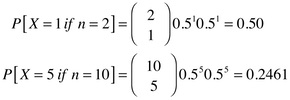
1. The omission of zero from the vertical axis magnifies the index's zigs and zags. Between 2:00 and 2:30, for example, the height of the line drops by 80 percent; yet, the actual decline in the Dow was only about sixth-tenths of one percent.
2. We need to know the fraction of all marriages that occurred in each month. In fact, because there are relatively more marriages in June and August (11.84 percent of all marriages take place in June and 11.70 percent in August), an examination of most marital characteristics will tend to find a preponderance of June and August marriages.
3. Assuming that each olive is equally likely to appear, the probability that the first olive will be black is 5/7 and, if it is black, the probability that the second olive will also be black is 4/6, since 4 of the six remaining olives will be black. Similarly, if the first two olives are black, the probability that the third will also be black is 3/5. Thus the probability of 3 black olives in a row is (5/7)(4/6)(3/5) = 2/7.
4. The president of the American Statistical Association wrote an enthusiastic review of this book; another statistician pointed out that Secrist had been fooled by regression toward the mean . In any given year, companies with exceptional profits relative to other companies are likely to have experienced good fortune.
5. The most appropriate graphs:
a. side-by-side box plots.
b. scatter diagram.
c. time series graph
d. scatter diagram.
e. side-by-side box plots.
6. We can use Bayes’ Rule, with 2H representing the two-headed coin and 5 heads representing 5 heads in a row:

7. Self-selection bias. The self-esteem of children who choose to participate may differ systematically from the self-esteem of nonparticipants. If so, we won't know whether the observed differences are due to the participation or to the kinds of children that participate. We might take a group of children who sign up for soccer and allow only a randomly selected subset to participate, leaving the rest as a control group. (It's cruel, but done all the time in medical research.)
8. Writing everything in thousands of miles for convenience, we use X ~N[30, 5] and
![]()
a. ![]()
b. ![]()
c. ![]()
d. ![]()
9. The binomial distribution with p = 0.5 is appropriate
a. 
b. Mrs. Romero is right. This is an example of the general principle discussed in connection with the law of averages: as the number of trials goes up, the probability of an exact 50-50 split declines.
10. Contrary to the fallacious law of averages, the accumulation of job rejections doesn’t increase a person’s chances of getting a job offer. In fact, a large number of rejections suggests that this person may have little chance of being offered this type of job.